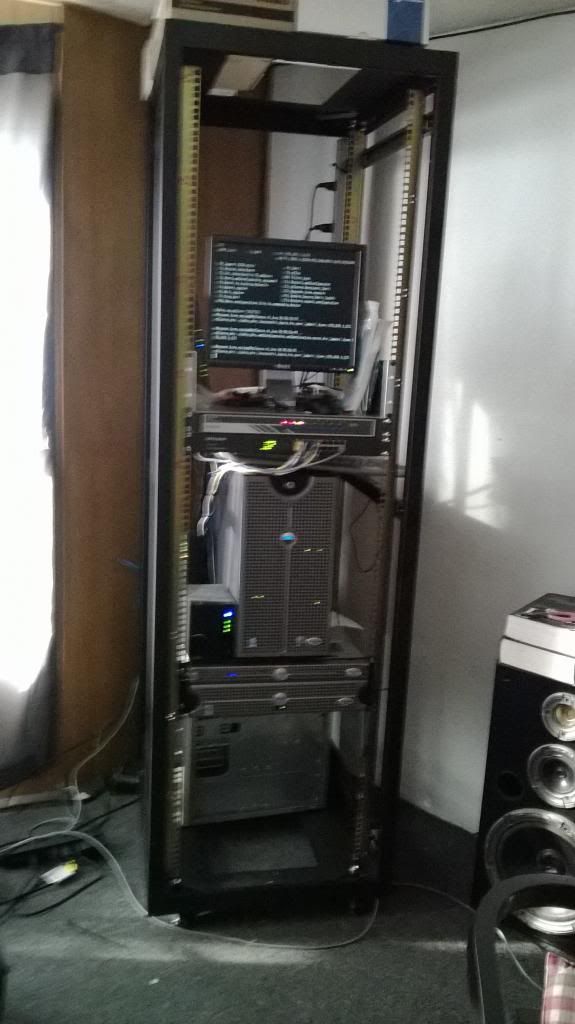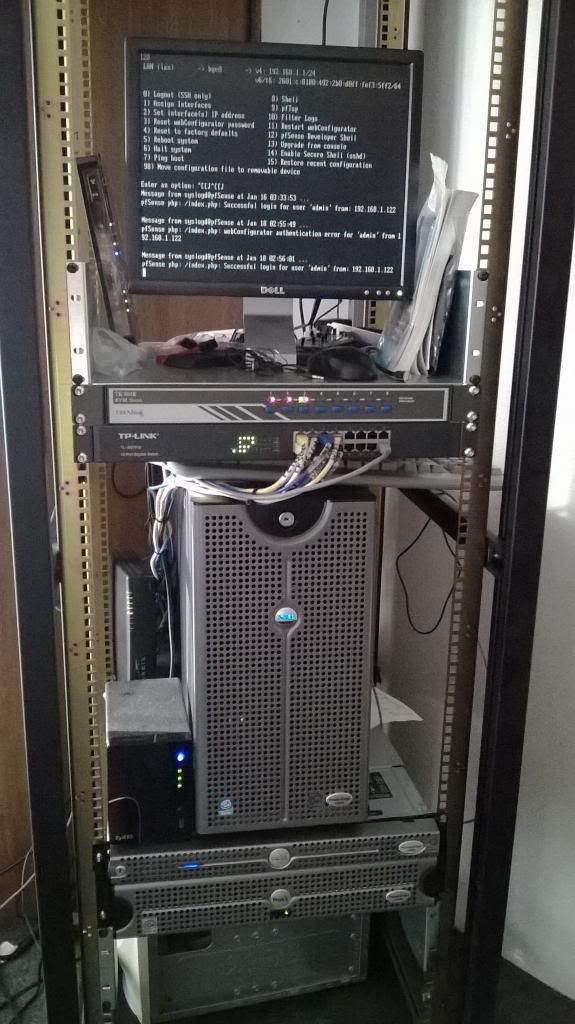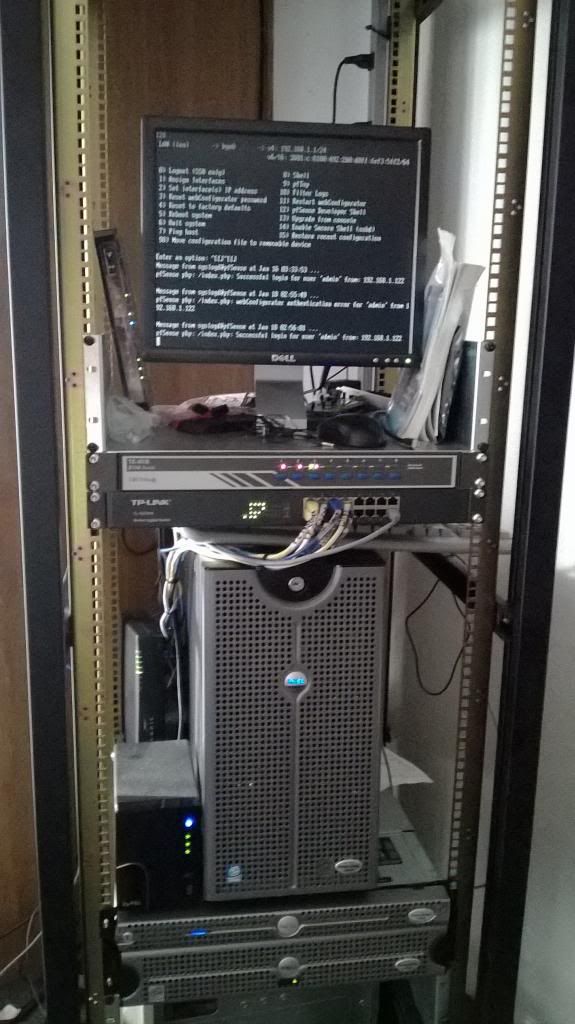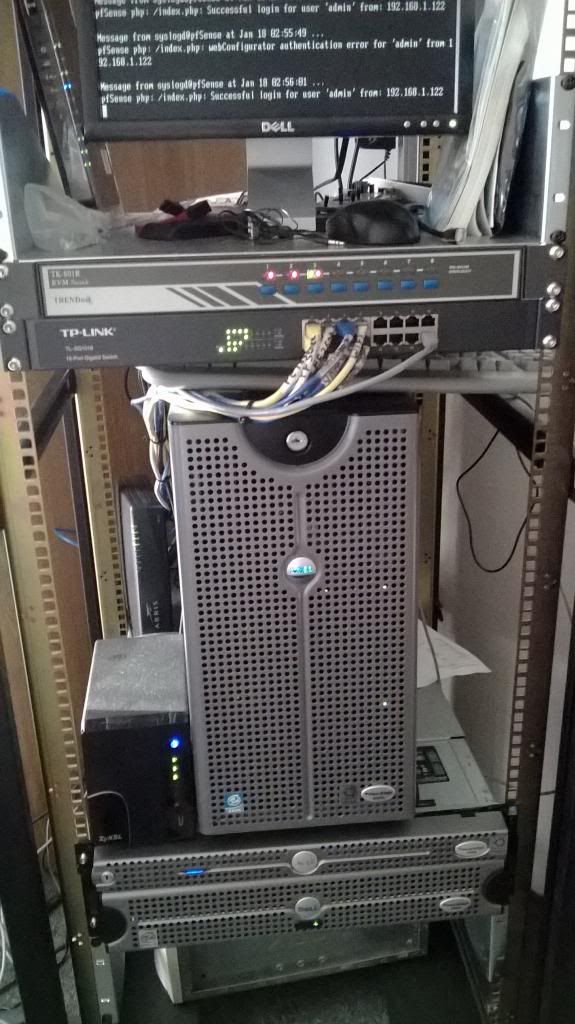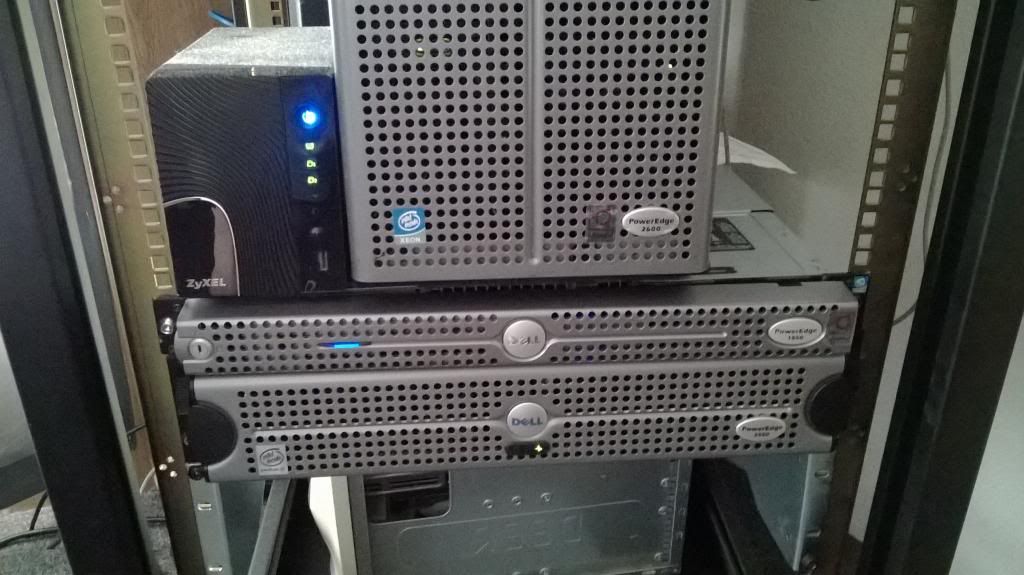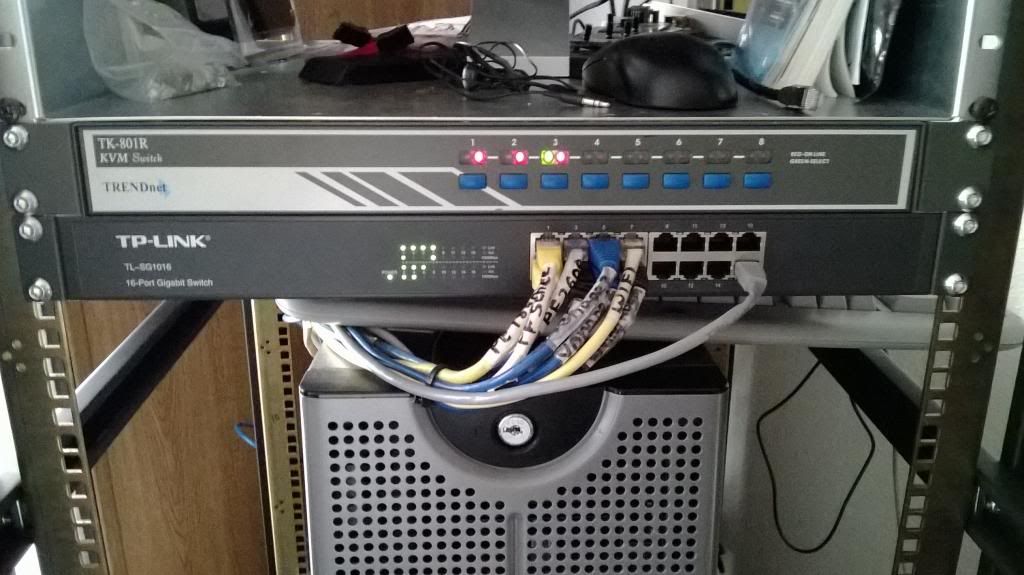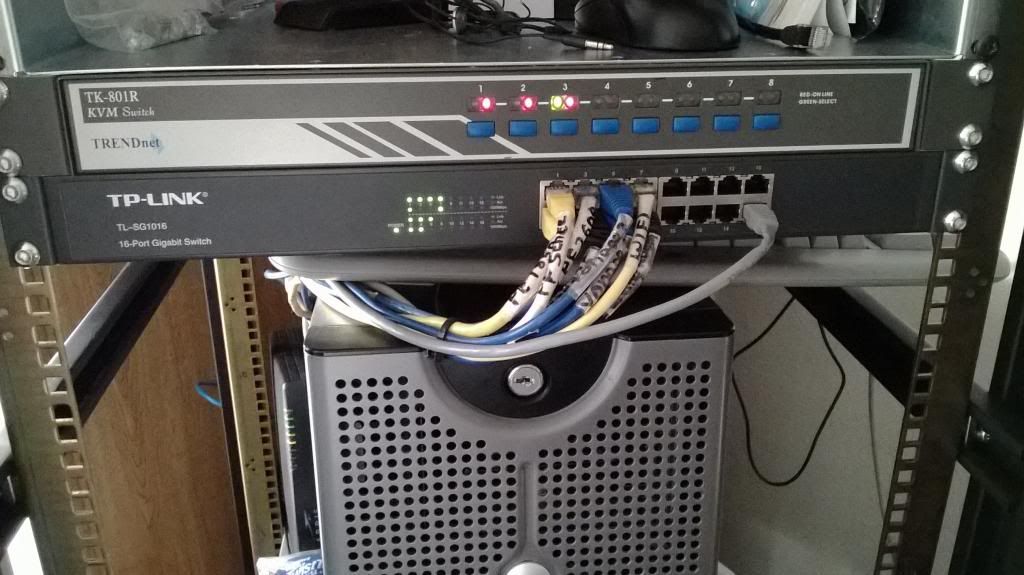[ Show your pfSenses! ] - Thread - (bandwidth warning!)
-
Yes! ;)
-
One that @tommics posted on Twitter.

-
This is a custom skeleton build running pfsense 2.1 RC1 (amd 64). This re-purposed computer started its life as an e-machine. The frame has been cut down significantly and re-riveted (was a micro atx case) to exact fit a mini itx motherboard. The case is now the width of the WRT54G router perched on top. Frame was smoothed and painted rattle can red. Build uses a standard ATX power supply from a dell dimension series taken apart and sprayed with flat black paint for contrast. I didnt want the pfsense 16g flash drive hanging out the back near my network cables so i made a custom mount inside the case partly salvaged from a hp pavillion. The power switch is also located on top of this mount taken from another dell. The meat and potatoes of this build is a brand new dual core intel celeron processor @ 1.1 ghz and 2 gb of G.Skill DDR3 1333 ram. The motherboard (gigabyte GA-C847N-D) has dual RJ-45's and I also installed a pci gigabit NIC for my optional interface running on a different subnet. Not doing anything real heavy duty with it yet, mainly pfblocker, VPN and bandwidth throttling my freeloading neighbors :)

 -
OK, I`ll share mine :)
pfSense box:

Mini rack:



Whole system, switches, server (5 HDD`s!!) and pfsense box uses around 110W, great what they did with power management :)


-
That needed a bigger bandwidth warning. ;)
I haven't been able to open the thread for the last three days via a 3G connection.Steve
-
Here's mine:

-
Here's mine…




Rack arrived today, so it's a work in progress…
Still need to finish up the wiring, and mounting the PDU's
Short a few rails and some of the stuff that's in there now will be removed and replaced before spring.2x HP R5500XR UPS
2x HP Proliant DL580 G4 - Quad Intel 7140M ( 3.40GHz Xenon Duo Core ), 64GB DDR2 2x 72.6GB 10K SAS ( RAID 0 )
1x HP Proliant ML370 G5 - Dual Intel X5450 ( 3.00GHz Quad Core Xenon ), 32 GB DDR2 ECC, 4x 36.6GB 15K SAS for OS + External Storage ( See MSA20 )
1x HP Proliant DL360 G4 - Dual 3.6GHz Intel Xenon's, 8GB DDR, 2x 72.6 GB 10K SCSI ( Soon to be replaced for DL380 G5 )
2X HP MSA20 - 5x 2TB + 4x 1TB Seagate Barracuda 7200 Drives ( Soon the be replaced by HP MDS600 )Other equipment:
HP AF600A KVM
Woven LB4 ( AKA TRX100 )
IBM Top Spin 120 ( AKA Cisco SFS7000 )
Older DLink Switch ( some older switch for the ILO and Management Network )PS:
DL380 G5 will be the new firewall...
Single 2.2GHz xenon, 8Gb DDR2, 2x 36GB 10K SAS + Mellanox card + Myricom 10GBEIn the end there will be lots of CX4 cabling in the rack as there will be the Dual Link Infiniband net and the 10 GBE loop between the Firewall - LB4 - NAS
-
As of today I have bought some more hardware that's inbound…
3 UPS's and a new drive array ( HP MDS600 ) -
Ok Ill bite. Still a work in progress. Supermicro X7SPA-H with 4gig of memory.
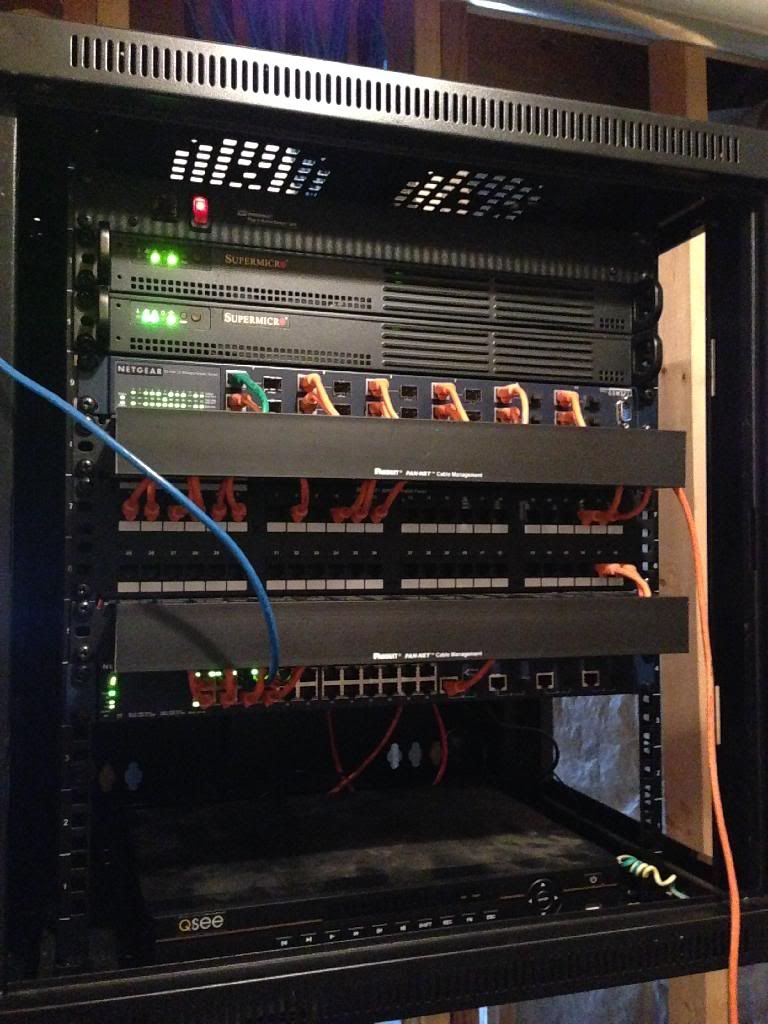
-
Nice! Very Clean!
-
-
Are you in the UK?
Steve
-
-
Here is mine. The rack I got it for 200 bucks. But guy selling for 100. I told him i'll give him 100 bucks more and yup he brought it. I love it I just need to get another shelf for back post to hold up my rack servers. Anyway's there more detail in this video. And here are pictures. Oh by the way the last bottom server is my firewall. Old p3 server working as a champ. :D
https://www.youtube.com/watch?v=vEcbFl6y5cc
-
Let's go from big to small. This stuff is direct-wired to 12V DC from 150AH tubular batteries, which are charged exclusively by solar:
Alix 2D13 pfSense (12V)
Cisco SF100D-05 100Mbps switch (12V)
Fit-PC3 running Windows Server 2008R2 (12V)
ISP wireless device (not shown) (24V DC POE feed from across 2 batteries)
QNAS (in another room) (12V DC)
and we plan to put a TP-Link TL-MR-3420 (also 12V) in place of the Cisco switch so we get GB from Fit-PC3 to QNAS, and get WiFi, all on 24/7 solar powered 12/24V DC.
-
Good stuff Phil. :)
I think I may have asked you this before and then forgotten, I can't remember! Are these powered directly from the batteries (~11-14V) or some regulated 12V source? Also do you have have some fancy charging/conditioning device between the panels and the batteries? I'm always interested in peoples solar power experiences.Steve
-
Panels, batteries and DC out are all connected to a charge controller. But the DC out is not particularly regulated, so the devices have to copy with 11-14V (at the most 10-15V), which they do. I will take some charge controller pics on Monday and also see if I can get some actual running DC power consumption numbers (watts) for each device. (The engineering guy putting together our "standard" office solar installation package has the necessary measurement gear)
Edit, added:
DC power consumption @ 13.8V from solar/battery system:
Fit-PC3 roughly idling - 0.9A = 12.4W, running hard - 1.5A = 20.7W
Alix 2D13 - 0.3A = 4.1W (hmmm, a little low to believe?)
Cisco SF100D-05 5-port 100Mbps switch - 0.15A = 2W
QNAS TS-212 - idling 0.7A = 9.7W - disks working 1.0A = 13.8W - in standby waiting for scheduled wake <0.1A = <1W -
-
Here's my new one… running on ESXi 5.5 ... Supermicro/Rangeley SOC :)

-
Messy I know, but here it is. My first OpenSource box outside of messing with Linux back around '97
This is a Haswell i5-4570 Quad core 3.2ghz (VT-X, VT-D, AES, RND, TSX-NI, No HT), with 8GB of 2x4GB G.Skill 8-8-8-24 1600 DDR3, 2x Samsung 120gb 840 EVOs, and an Intel i350-T2. The switch is an HP v1810-24G, which is a L2 managed switch.
Currently, the green cable is WAN side for the box and red is the LAN, but I will be changing WAN to yellow and LAN to green. The white cable is from my old router which is a Netgear 3700 acting as a wireless AP with no DHCP, grey is my computer, which has the management VLAN tagged to my port and the empty port below is an untagged management VLAN. All other ports to the left are untagged "LAN" VLAN. Blue is the wife's comp.
No conf file tweaks or anything. A fairly standard install plus the Unbound package.

I was able to run some very simple benchmarks where my wife's computer was on one side of the firewall and mine was on the other. I was using PSPing which is like iperf. I had 4 instances running, 2 sending and 2 receiving. I actually get the same throughput directly over the switch as I do through PFSense, about 1.3gb/s total. My throughput limitation seems to be the cheaper Intel NICs on mine and my wife's comps.

System load during the above benchmark. These are the worst numbers.

When using hrping, which is similar to the Unix ping and uses the Windows media timer, I get the exact same average ping and exact same std-dev through PFSense as I do directly on the switch.
I am not sure how it will stand up to lots of connections. If I had a way to simulating several thousand UDP+TCP connection, running as fast as they could, in Windows without paying for software, that would be nice. Unfortunately it seems the only good free tools exist for Posix OS's.
One issue that I did have while installing PFSense is some bug that causes the install to hang at 36%. The work around was to unplug my keyboard before it got to 36%, which is a feat to do so on a quick install with a 3.2ghz CPU and SSD. Because I could not get this to work with the GEOM setup, I am stuck with using one HD for now. I plan on giving it another shot once 2.2 comes outs. Hope root on ZFS is supported.
P.S. The candy box in front of the computer is to block an insanely bright blue LED. If you're back on the couch, it is quite annoying.
